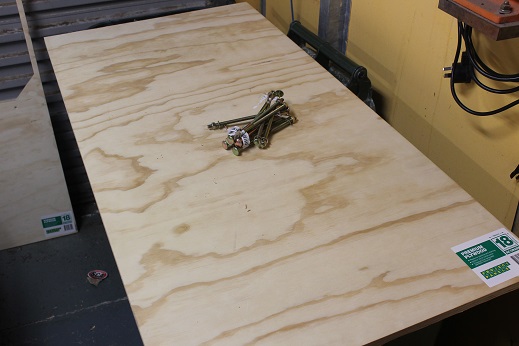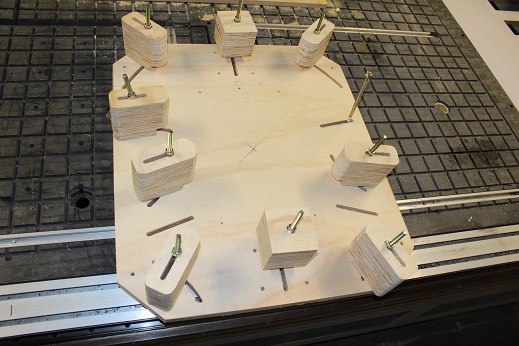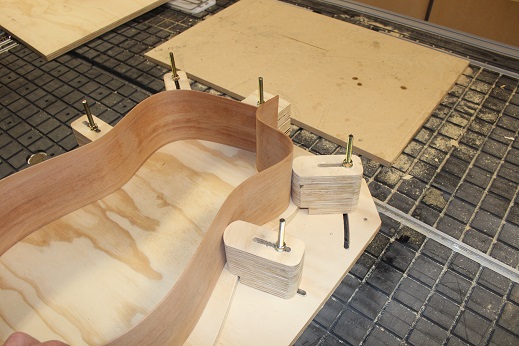
 |
|
#1
|
|||
|
|||
|
https://www.ebay.com/itm/Universal-A...wAAOSwQjxbr8bx
Hope my link works. Looking at a universal homemade type board design. It is either this or waiting around for a second hand LMI mold. I just dont want to spend $150 on a mold for one type guitar. Not knowing if building will even be for me. |
|
#2
|
|||
|
|||
|
By the way, not so much that mold but the design itself? I have also seen this design using large dowels like like a closet rod.
As I've read here and others, "If you can't build the mold, you can't build a guitar." |
|
#3
|
|||
|
|||
|
I made this type of jig to hold sides in shape when removing the back is necessary. I wouldn't want to build from one myself.
Inner forms can be made from almost any material for a one time use. Stiff cardboard glued together to the thickness required will work fine. My first inner forms were made from 1/2" plywood separated with 2"x 2"'boards. Still use several of them. My outer forms are from high grade 11 ply stock glued and screwed together and cut out on a bandsaw. |
|
#4
|
|||
|
|||
|
One I made earlier.
Cost is about 15 us dollars unless you want to scrounge for some scrap wood to start with. Steve   
__________________
Cole Clark Fat Lady Gretsch Electromatic Martin CEO7 Maton Messiah Taylor 814CE |
|
#5
|
|||
|
|||
|
The basic concept works very well. Iíve used it for the past four decades. That particular one can easily be improved upon.
A 2x4, a piece of 3/4Ē plywood, a length of 2Ē diameter curtain rod, a length of threaded rod and some washers and butterfly nuts is all you need to make your own. |
|
#6
|
||||
|
||||
|
You really donít need a mold at all. I havenít used one for 20 years. People say it take more skill, but thatís because they havenít tried it. Look at pictures in my threads.
|
|
#7
|
|||
|
|||
|
Watched some youtube videos of a British guy bending sides on an iron. Basically saying what you are. said with an iron he just glues and clamps the blocks when he is done bending?
|
|
#8
|
|||
|
|||
|
Bruce is right, of course; "you really don't need a mold at all." But while he notes that he hasn't used one for 20 years, he's been building (really fine) guitars for close to 50 years.
Following Bruce's lead, the last two guitars that I built were done without molds. The first one came out fine -- I now realize that was beginner's luck. The second one, still under construction, is noticeably non-symmetrical in the lower bout. My next build will use a mold. One day I'll try again to build without a mold. YMMV. |
|
#9
|
|||
|
|||
|
I have taken some of Bruce's methods of building along with other's and am still trying different ideas depending on the type of guitar build. Bruce does not use a mold but he does use a board to build off of which the top is clamped to through the sound hole. The sides are then built onto the top then back glued on.
I have been making some experimental guitars and going to the effort of making a mold for what may be a one time event seems wasteful. I had been building off the radius dishes I use. Here is a ukulele I built recently.  I have a gobar deck setup and have a few rods pushing the top down to take the dished shape. I am gluing on the neck and tail blocks to the top. The important aspect is that I am using a 2"x2" with squared off ends to hold the blocks parallel to each other. I placed some sandpaper on the top and 'flossed' the mating surface of the blocks to the radius of the dish. With the rods holding the one end down it is easy to hold the sandpaper under the other end and sliding the block over it back and forth to sand in the shape. When done just clamp that side down and do the other end. Makes for a good glue joint. With the two ends glued I then take the sides and align them to the ends. I mark the radius of the dish onto the sides and trim away the excess till I get a reasonable fit. You could make another quick aid out of scrap material to check and align the sides so they are square. When satisfied glue one side to the end blocks. When dry remove the 2"x2" and glue the other side. Next step is to glue in the tentelones (the lining blocks). Bruce usually uses hide glue and used Titebond for his daughter's guitar, I was surprised by this but tried it and it worked for me also. It does take a while gluing in the blocks as compared to using kerfed lining and clamping them to the sides but it is a relaxing process. Being a simple build I took more care with the side fit of the uke, flossing the edges, and the surfaces mated well enough so I did not have to bind the edges.  I can't remember but I am guessing I tacked the sides to the back (this build I glued to sides to the back first and then glued the top on) with CA glue and then glued the tentelones in next. I did my first Spanish Foot build like that, actually used CA for the tentelones also. Made for a fast build and the guitar is a few years old and has held up fine.  Once the sides are glued on with tentelones then the box is stable enough to glue kerfed linings on the other surface as normal. Another variation of the method would be to glue the sides onto the end blocks using the 2"x2", then while sitting in the dish (After the radiused shape is roughed out on the sides) regular kerfed linings could be glued on. That is how I did this body, picture as I am marking the brace notches into the linings. The burn in the one corner was my last, during bending these sides I realized I could put a damp rag on the pipe and bend the sides as the water steamed off of the rag.  So a mold is not necessary in building. It does help if you want to get an exact shape to your sides. Bruce bends his sides on a Fox style bender, this gets the shape close to desired and not much finessing needed. Bending by hand can introduce some variability in the shape but with practice you can get pretty good at matching what you are aiming for. So lots of ways of skinning a cat.
__________________
Fred |
|
#10
|
|||
|
|||
|
Donít confuse a bending jig with a building mold. A building mold is frequently used with sides that are almost being pushed or forced into the mold so that the top and back of the guitar are used almost like braces to maintain that shape, creating a box that can have a small amount of built in internal tension or stress. The ďno moldĒ style usually relies more heavily on the sides being bent well to the correct shape (usually using a good bending jig) so that virtually no effort is needed to maintain that shape, and the top and back are attached to them, creating a box that has little to no tension internally, allowing the lightest string energy to activate it musically. Its a building concept that allows for a far lighter and more resonant box, if thats what youíre looking for -
The mold you referenced would be fine, but as has been noted, you should be able to create one of those rather easily if your goal is to build a guitar -
__________________
More than a few Santa Cruzís, a few Sexauers, a Patterson, a Larrivee, a Cumpiano, and a Klepper!! |